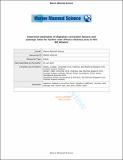Files in this item
Improved estimates of digestion correction factors and passage rates for harbor seal (Phoca vitulina) prey in the northeast Atlantic
Item metadata
| dc.contributor.author | Wilson, Lindsay J. | |
| dc.contributor.author | Grellier, Kate | |
| dc.contributor.author | Hammond, Philip S. | |
| dc.date.accessioned | 2018-08-20T23:40:36Z | |
| dc.date.available | 2018-08-20T23:40:36Z | |
| dc.date.issued | 2017-10 | |
| dc.identifier | 250475053 | |
| dc.identifier | 1a482069-de9a-49ed-8179-3f81e22d5129 | |
| dc.identifier | 85031801529 | |
| dc.identifier | 000413358500009 | |
| dc.identifier.citation | Wilson , L J , Grellier , K & Hammond , P S 2017 , ' Improved estimates of digestion correction factors and passage rates for harbor seal ( Phoca vitulina ) prey in the northeast Atlantic ' , Marine Mammal Science , vol. 33 , no. 4 , pp. 1149-1169 . https://doi.org/10.1111/mms.12436 | en |
| dc.identifier.issn | 1748-7692 | |
| dc.identifier.other | ORCID: /0000-0002-2381-8302/work/47531651 | |
| dc.identifier.uri | https://hdl.handle.net/10023/15848 | |
| dc.description.abstract | Diet composition in pinnipeds is widely estimated using hard prey remains recovered from feces. To estimate the size and number of prey represented in fecal samples accurately, digestion correction factors (DCFs) must be applied to measurements and counts of fish otoliths and cephalopod beaks. In this study, 101 whole prey feeding trials were conducted with six harbor seals (Phoca vitulina) and 18 prey species. We derived species- and grade-specific estimates of digestion coefficients (DCs) and species-specific recovery rates (RRs) to account for partial and complete digestion, respectively. Greater than 98% of otoliths were passed within three days of consumption. RRs were smallest for Atlantic salmon smolts (RR = 0.306, SE = 0.031) and increasingly larger for sandeels (RR = 0.494, SE = 0.017), flatfish (RR = 0.789, SE = 0.033), and large gadoids (RR = 0.944, SE = 0.034). Species-specific otolith width DCs were smallest for Trisopterus species (DC = 1.14, SE = 0.015) and increasingly larger for flatfish (DC = 1.27, SE = 0.045), large gadoids (DC = 1.32, SE = 0.067) and sandeels (DC = 1.57, SE = 0.035). RRs were similar to those from gray seals (Halichoerus grypus), but harbor seal species- and grade-specific DCs were generally smaller. Differences in partial and complete digestion rates among prey species and between seal species highlight the importance of applying DCFs when reconstructing diet. | |
| dc.format.extent | 1268523 | |
| dc.language.iso | eng | |
| dc.relation.ispartof | Marine Mammal Science | en |
| dc.subject | Digestion | en |
| dc.subject | Digestion correction factor | en |
| dc.subject | Digestion coefficient | en |
| dc.subject | Recovery rate | en |
| dc.subject | Passage rate | en |
| dc.subject | Harbor seal | en |
| dc.subject | Diet | en |
| dc.subject | Prey | en |
| dc.subject | Otolith | en |
| dc.subject | Beak | en |
| dc.subject | QH301 Biology | en |
| dc.subject | NDAS | en |
| dc.subject.lcc | QH301 | en |
| dc.title | Improved estimates of digestion correction factors and passage rates for harbor seal (Phoca vitulina) prey in the northeast Atlantic | en |
| dc.type | Journal article | en |
| dc.contributor.institution | University of St Andrews. School of Biology | en |
| dc.contributor.institution | University of St Andrews. Sea Mammal Research Unit | en |
| dc.contributor.institution | University of St Andrews. Centre for Research into Ecological & Environmental Modelling | en |
| dc.contributor.institution | University of St Andrews. Scottish Oceans Institute | en |
| dc.contributor.institution | University of St Andrews. Marine Alliance for Science & Technology Scotland | en |
| dc.identifier.doi | https://doi.org/10.1111/mms.12436 | |
| dc.description.status | Peer reviewed | en |
| dc.date.embargoedUntil | 2018-08-21 | |
| dc.identifier.url | http://onlinelibrary.wiley.com/doi/10.1111/mms.12436/full#footer-support-info | en |
This item appears in the following Collection(s)
Items in the St Andrews Research Repository are protected by copyright, with all rights reserved, unless otherwise indicated.

